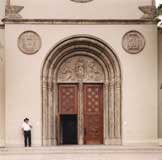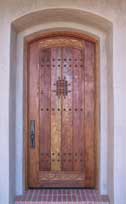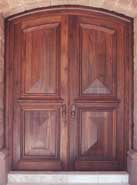| CWB August
2002
Big Doors in Arizona Wayne Hausknecht builds massive entry doors that make a statement in Tucson-area homes. By Helen Kuhl
Hausknecht started building homes in Colorado and moved to Tucson in 1978, where he worked with a builder interested in reviving adobe-style homes. The builder had problems finding someone to do interior millwork and cabinetry in a high-end rustic style to match the homes. So Hausknecht took over that task, working on-site in the garage as soon as the shell was complete. “I had done interior work for custom homes in Colorado and had a lot of tools,” he says. “It kept me out of the sun.” Although the houses did not sell as quickly as the builder had hoped and he eventually gave up on the project, Hausknecht’s interior work had been noticed by customers, and he had enough requests for his custom woodwork to go out on his own. He also had a chance to buy an affordable building that could be used as a shop. So he began his own business on Jan. 1, 1981, initially doing kitchen cabinets and built-ins as well as doors, but soon specializing in just doors.
A steady market and
consistent backlog One reason for the backlog is that Hausknecht likes to build doors one at a time and says that his favorite job is always “whatever I’m working on at the moment.” While some doors are designed by an architect, most are a collaborative effort between Hausknecht and the homeowners. He spends a lot of time “interviewing” the homeowner, looking at their sketches or photos to see what they like and also finding out what woods and styles will be used on the interior of the home in order to develop a compatible door design. Doors can range from simple, rustic styles to elaborate designs with hand-carved elements, “speak-easy” doors, mouldings, rosettes, grilles and other decorations. They can take from a couple of days to eight weeks to build, depending on how elaborate they are. Most of his customers are looking for a massive entryway and need an odd-sized door, which is why they must have it custom-made. Hausknecht’s doors are often as much as 3 or 4 inches thick and 8 feet tall. He not only designs and builds the doors, but also does the finishing and installation. Although Hausknecht works by himself, he sometimes hires extra help to do installations and be able to maneuver the heavy doors on-site. Picking the right
woods He starts a door from the raw lumber stage, doing the rough milling himself, and says he is very picky about the wood he selects. “A standard door is 1-3/4 inches thick. I need to get my wood full rough, so I have to have enough material to flatten it out and get it sanded to end up with 1-3/4 inches. A lot of lumberyards carry lumber S2S and it’s only 1-13/16. So I actually have to special order a lot of my wood to bring it in full rough,” Hausknecht says. “I have to have a good working relationship with my lumberyards, where they know how picky I am. Because if I order lumber and they bring it in from Phoenix or the West Coast, it has to be good or I’ll send it back.” After the lumber is rough milled, Hausknecht sorts through it to find boards that are long, wide and flat enough for the stiles of the frame. “Usually I am making the frame of the door first, because that’s the most critical part,” he says. “The frame has to be real flat.”
“I like doing panels one board wide or two,” he adds. “I like to do doors with no glue lines, except for the obvious ones where the door is put together. It’s the way doors would have been made 100 years ago, when they had big trees.” Hausknecht also says that he is not afraid to waste wood in order to get the best look. “If a piece of wood would look good in a certain area of a door and to get it I will have a 2-foot scrap on one side and a 4-foot scrap on the other side, I’ll cut it anyway,” he says. “I won’t try to get two pieces of wood out of the board in order to save money or save wood. If I cut corners, the finished product will not be what I really want it to look like.” In cases where Hausknecht cannot obtain material that is thick enough for a very thick door, he will laminate boards. “I take boards that are 1-3/4 inches thick, mill them down to 1-1/4 inch or 1-3/8 and put two of them together, using a vacuum bag veneer press and letting them sit overnight” he says. “That’s why a thicker door sometimes costs more, because it can take twice as much material and twice as much milling time, plus the glue and time in the press.” The woods most commonly used are Honduras mahogany, rough fir, walnut, cherry and mesquite. The mesquite is popular but expensive, Hausknecht says. “It has to be either kiln dried, which costs more, or a lot of times I buy the wood air-dried or just after it is cut. Then I have to hold it for about a year per inch of thickness, so it will take generally two years before I can use it. When a supplier comes by, I try to buy as much as my budget can afford so I will have it on-hand when I need it.” Mesquite also has a lot of checks and voids that require preparation, which adds to its cost. The voids and checks are filled with a lamp black epoxy, which doesn’t shrink when it dries. Black is used because of the strong sunlight in the area, Hausknecht says. Mesquite changes color with sunlight, and any other color of epoxy also would change, so over a short period of time there wouldn’t be a match. The black filled areas are visible and are part of mesquite’s distinctive look. Although Hausknecht uses a lot of solid mesquite, he also makes his own 1/8-inch mesquite veneer if a customer wants a plain, flush door style. For such a door, he usually buys a manufactured solid core door with a porous veneer on it, such as mahogany, then puts 1/4-inch MDF on each side as a substrate for the veneer. He uses epoxy adhesive and the vacuum bag press to lay it up. Equipment to do the
job Machinery includes: 10-inch and 16-inch Rockwell radial arm saws, a 10-inch Delta table saw, a Powermatic 12-inch table saw, a 6-inch Powermatic joiner, a 16-inch-wide J.A. Fay joiner, a 14-inch Delta bandsaw, a 10-inch Rockwell bandsaw, a 16-inch Powermatic planer and a Powermatic hollow chisel mortising machine.
His vacuum bag press is from Mercury Vacuum Systems, and he does all his mouldings on a Williams and Hussey moulder. He has a Powermatic disc belt sander and does a lot of sanding with portable power tools. He can also rent time on a widebelt sander at other cabinet shops in the neighborhood as needed. Hausknecht does all his finishing in the shop, using traditional oil-based finishes that are brushed on. He has developed a finish system that works well in the strong Arizona sunlight. “After I stain, I put on a base coat of Deft exterior oil, let that soak in and wipe off the excess, to really seal the wood,” he says. “Then I use a mixture of McCloskey spar varnish and Water Lox, which is a really thin tung oil varnish. They are mixed about half-and-half. I brush on a couple of very thin coats, sanding in between, and then end with a paste wax.” The finish usually lasts anywhere from six months to two years, depending on how much direct sunlight the door is getting, Hausknecht says. With this system, a door can be refinished easily after it degrades from the sun. Most of Hausknecht’s work is residential, but he has done some commercial jobs, including doors for local area churches. Although most of his work comes by word-of-mouth, Hausknecht enjoys working on computers and created his own Web site, www.wghwoodworking.com. He says that it saves him time when people first inquire about his work — he directs them to the Web site to see examples of his doors. This can help screen out some prospects who might not be able to afford him. In the two years that the Web site has been online, it has had over 9,000 hits, Hausknecht says, and continues to grow. Although he is not really trying to expand beyond his local area, he has gotten door orders from Wisconsin and Texas through the site. “I get people worldwide looking at it,” he says, “and it’s easier to update than my photo portfolio. I can take photos with my digital camera and get them on the Web site in hours if I want to.” Although Hausknecht does not reveal his annual sales, he says that a residential door can easily cost $5,000 to $6,000 and up. That does not include the door hardware, which customers choose from an outside vendor and can cost as much as $1,500. Hausknecht estimates that he does around 10 doors each year. While he enjoys concentrating on doors and is not interested in doing any boxwork, Hausknecht does do occasional pieces of furniture when customers ask. He says he wouldn’t mind expanding in that direction sometime in the future. “I have always admired people who do antique reproductions, although there is not too much of a call for that in Tucson, that I know of,” he says. “As I get older, though, I would like to do more hand-made custom furniture, because the doors get heavy.” |
|
Search ISW Online · Portal · Redbook Online · Virtual Trade Show · Ad Info | ||
| Industry News · E-Info · Free Subscriptions · Forum · Woodworking Index | ||
| Classifieds · Coming Events · Bookstore · Publicize Yourself · Contact Us | ||
COPYRIGHT © 2003 - VANCE PUBLISHING, ALL RIGHTS RESERVED | ||


